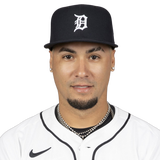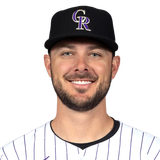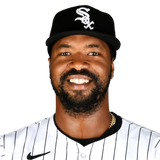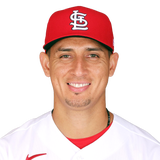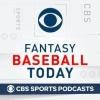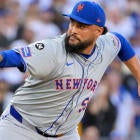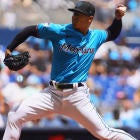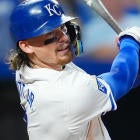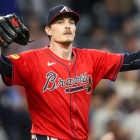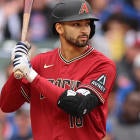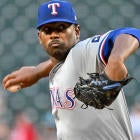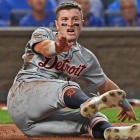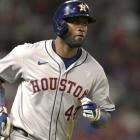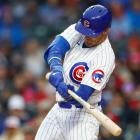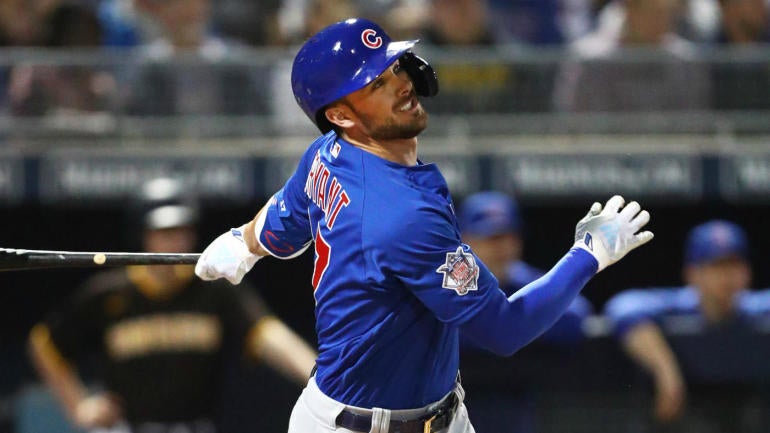
The rankings have been updated, mock drafts are coming fast and furious, and you could actually watch real baseball the last few days — yep, the MLB season is getting close. Which means Fantasy Baseball Draft Prep season is here, which means it's time for one of my favorite pastimes: Nitpicking my colleague's rankings.
We've been going through our updated position previews on the Fantasy Baseball Today Podcast over the past few weeks, which has meant diving back into Frank Stampfl and Scott White's rankings. And anytime you do that, you're bound to come across disagreements -- we haven't developed a hive mind yet.
Those disagreements are, of course, good. You get to hear both sides of an argument before coming to your own conclusion, and that's always going to be the best process. Here I've highlighted 10 of their biggest disagreements for 2020, going into what exactly it is they disagree about with each player, and then providing you my perspective on who has it right.
And if you disagree, well that's OK, too. At least now you've heard what you need to hear to make that decision.
| ||||||||||||||||
Where is the disagreement? It's worth noting that both Frank and Scott are higher on Morton than the consensus, so it's not like they disagree -- Fantasy Baseball Today is a Charlie Morton fan podcast. But, while Scott generally ranks pitchers higher than Frank in their overall rankings, this is one early outlier; Morton is Frank's No. 1 SP, compared to No. 15 for Scott. As we discussed in Part 1 of our starting pitcher preview, it may come down to the simple fact that the shortened season erases whatever injury concerns Frank might have had for Morton:
Who is right? If you ask me, those injury concerns were always overblown. Morton has made at least 28 starts in each of the past three seasons (counting three rehab starts for his lone IL trip in that span, back in 2017). He may not be your traditional innings-eating ace, but make no mistake about it, Morton is an ace. Only nine pitchers have thrown at least 500 innings over the past three seasons with a lower ERA than Morton's, and only eight have had a lower WHIP. I'm with Frank; Morton is the cheat code to unlock your pitching staff on Draft Day.
| ||||||||||||||||||
Where is the disagreement? I think it's as simple as this: Scott thinks Baez is a much more volatile player than Frank does. Baez has proven himself over his past two seasons, but there's still that issue of Baez's poor plate discipline, which means he relies on outlier success when he does put the ball in play. Baez's upside can make up for that, but given that Baez was only the No. 51 hitter in Roto in 2019 on a per-game basis, it's fair to wonder how high that upside is.
Who is right? I get lumped in with Scott when we discuss this on the podcast, but I'm really more in the middle. Baez is a strange bird — his all-around skill set makes him a pretty high-floor player, despite a volatile approach at the plate. His 2018 stands as the high-water mark, but 2019 really wasn't that big of a drop-off. The plate discipline scares me, but I'm probably more on Frank's side here; I don't think drafting Baez is likely to hurt you much.
| ||||||||||||||||||
Where is the disagreement? Same team, opposite rankings. This is another upside vs. safety debate. Bryant has surprisingly mediocre batted-ball data for a guy whose calling card was once a potential 80 power grade. He's settled in, weirdly enough, as just an average power hitter, one who serves more of a table-setting role for the Cubs than a run-producing one. Bryant seems pretty likely to be a must-start player, and both have him ranked that way; Frank just doesn't see the upside that makes Bryant worth reaching for.
Who is right? In this one, I'm more on Scott's side. Bryant does really have surprisingly mediocre batted-ball metrics, ranking in the 23rd percentile in average exit velocity and 25th percentile in hard-hit rate in 2019, per BaseballSavant.com. With an expected batting average of just .246 and an expected ISO of .214 — as compared to a .282 and .239 mark in reality — it's fair to say he might have wildly over performed. Except ... that's what Bryant does. He sports a career .383 wOBA compared to a .367 xwOBA, and has outperformed that number in each season of his career. It may defy a lot of sabermetric conventional thinking, but you shouldn't hold that against Bryant. He's not particularly exciting, but Bryant is the kind of player you never have to worry about. That has plenty of value.
| ||||||||||||||||
Where is the disagreement? Another one where the overall rankings may not quite capture the distinction, because Frank has Paddack as his No. 14 SP, compared to No. 19 for Scott. Paddack was excellent as a rookie, but the disagreement ultimately comes down to whether you think he's going to take a step forward. Frank does, especially with workload concerns in the rear-view mirror.
Who is right? I wouldn't take Paddack as high as either has him ranked. I suppose that means I side with Scott, but I'm much more skeptical about Paddack's chances of making the leap to ace-dom. Paddack is mostly a two-pitch pitcher, throwing his curveball just 10.4% of the time. Not that he should've thrown it much more often, because the pitch had the lowest whiff rate of any of Paddack's pitches, along with the highest xwOBA. I'm worried Paddack is going to struggle to pitch effectively deep into games until that curveball improves, and his peripherals indicate he was pretty luck in 2019; his 3.33 ERA came with a 3.95 FIP and 3.83 SIERA. Paddack needs to get better to avoid regression.
| ||||||||||||||||||
Where is the disagreement? This one is sort of representative of a larger philosophical difference — Scott is more likely to buy into the one-year wonders, especially if there is underlying data to back it up. And there is plenty for Gallo, who remains one of the league's Statcast darlings, ranking fifth in average exit-velocity, third in hard-hit rate and third in barrel rate. However, that wasn't anything new for Gallo — what was new was his batted-ball mix, as he hit more line drives and specifically hit fewer balls on the ground when he hit it to his pull side. Those two things helped Gallo's BABIP spike from .249 to .368. If Gallo can really keep hitting .250 moving forward, he's a superstar with his elite power and surprising speed.
Who is right? It pains me to say it, because I've been one of Gallo's biggest boosters, but I'm with Frank here. Gallo's batted-ball profile did improve, but we're talking about pretty minuscule sample sizes here — 364 players had more batted balls than Gallo in 2019. One-year batted-ball and BABIP trends are hard to trust in the best of circumstances, and Gallo's specific profile -- tons of strikeouts, tons of home runs -- means it's even harder to trust. It may have been a real improvement, but given how plentiful power is, I can't justify a huge investment in Gallo.
| ||||||||||||||||||
Where is the disagreement? Frank has planted his flag on Eloy Jimenez Island, pegging him as one of his biggest breakout calls for 2020, and Jimenez showed us what the upside is when he hit .292/.325/.544 with a 40-homer, 110-RBI pace upon returning from the IL in late July. Frank is willing to bet on that being the start of something big, especially given Jimenez's prospect pedigree.
Who is right? I'm more with Scott on this one, though I'll say the same thing about Jimenez as I will about his fellow sophomore, Vladimir Guerrero: "Avoid him at your own peril." The most-likely outcome for Jimenez is that he takes a small step forward, which would be something like what Franmil Reyes or Eduardo Escobar offer. Those are solid players, but they aren't being drafted nearly as high as Jimenez. That's because the upside if Jimenez does hit probably puts him in the third round next season. People want to be there for the Rafael Devers-esque breakout.
| ||||||||||||||||
Where is the disagreement? You might think it comes down to whether Scott believes Bauer can recapture some of the magic from 2018, but that isn't really it. Bauer's primary appeal actually lies in the fact that he's a reliable source of strikeouts and innings, pitching for what should be a pretty good team. If the ERA dips into the mid-3.00s range, all the better!
Who is right? As someone who bought into Bauer's breakout big time -- I had him as the No. 4 SP last season -- you might think I'd be gun shy. And, while I don't love him at Scott's rank or his draft price, I'm not as pessimistic as Frank. Though, it should be said, Bauer's career certainly makes it look like 2018 was the outlier of all outliers -- it's the only time he's had an ERA below 4.00. At a certain point, it's fair to ask if you can replicate his production by streaming.
| ||||||||||||||||
Where is the disagreement? Here we go with another of 2019's breakout stars, except in this case, even Scott isn't buying fully into it. Minor was SP23 last season, and nobody is valuing him that way, primarily because the peripherals don't back it up — his 3.59 ERA was matched with a 4.25 FIP that indicates he benefited from plenty of good luck. Still, Minor did throw 200-plus innings with 200 strikeouts, and has always been a good source of WHIP, even when things didn't fall into place like they did last season. Like Bauer, there's value in that kind of volume, right?
Who is right? I'm with Frank entirely on this one. Even if Minor falls, I'm usually more interested in targeting upside pitchers like Kenta Maeda, Joe Musgrove or Mitch Keller. Minor's best-case scenario is still a mid-rotation arm, and given how unpredictable pitching will be in 2020, I'd rather go for players with higher-end outcomes.
| ||||||||||||||||
Where is the disagreement? Frank doesn't think Gallegos will be the Cardinals closer. Scott is more optimistic.
Who is right? Ask Mike Schlidt. How should I know? OK, that's not a good answer, but it's the right one. If Gallegos is named the closer, he'll belong in the top 150 given how dominant he was in 2019. If he isn't, well, he can still help you in ratios, but that's only so valuable. I'm more on Scott's side, though the fact that Gallegos isn't with the team yet doesn't help his chances, or those of Scott.
| ||||||||||||||||
Where is the disagreement? Musgrove has always had his fans in the Fantasy community, and he can count Frank among them. Musgrove has always had pinpoint control and pretty good ground ball rates, but despite a legitimate five-pitch arsenal, strikeouts have been hard to come by. That started to change at the end of 2019, as his four-seam fastball velocity jumped to 94.5 mph, higher than it had been during his very successful time as a reliever. If he can sustain those velocity gains -- reports from back in spring were promising -- Frank is willing to bet on a breakout coming.
Who is right? I'm willing to make that bet, too. By the time we reach the 14th round in most of our drafts, it's usually a race between Frank and I to take Musgrove, and I usually win. The Pirates are adopting a more analytics-heavy approach to coaching their pitchers up, and they should be able to get better results from Musgrove's deep arsenal — his slider, curveball and changeup all need to be featured more prominently. It's no guarantee, but Musgrove is one of my favorite mid-round pitching targets. He's why I'm not drafting the Mike Minor types.





